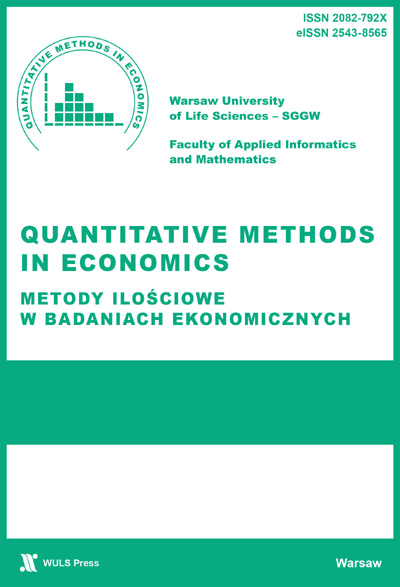Main Article Content
W niniejszym artykule przedstawimy system eliminacji szumów z wielowymiarowych szeregów czasowych. Elementami tego systemu będą bloki: dekompozycji PCA/EVD, grupowania oparty na funkcji dywergencji alpha, dekompozycji odwrotnej PCA oraz filtracji indywidualnej. W ramach etapu grupowania przedyskutowane będą typowe problemy tego zadania, motywujące do poszukiwania nowych rozwiązań. Zaprezentujemy także eksperymenty potwierdzające słuszność opracowanej koncepcji.
Article Details
Agrawal R., Gehrke J., Gunopulos D., Raghavan P. (2005) Automatic Subspace Clustering of High Dimensional Data, Data Mining and Knowledge Discovery, 11, 5-33. (Crossref)
Amari S. (2012) Differential-Geometrical Methods in Statistics. Springer Verlag.
Amari S. and Nagaoka H. (2000) Methods of Information Geometry. Oxford University Press, New York.
Amorim R. and Hennig C. (2015) Recovering the Number of Clusters in Data Sets with Noise Features using Feature Rescaling Factors. Information Sciences, 324, 126-145. (Crossref)
Bregman L (1967) The Relaxation Method of Finding a Common Point of Convex Sets and its Application to the Solution of Problems in Convex Programming. Comp. Math. Phys., USSR, 7, 200-217. (Crossref)
Celebi M., Kingravi H., Vela P. (2013) A Comparative Study of Efficient Initialization Methods for the k-Means Clustering Algorithm. Expert Systems with Applications, 40(1), 200-210. (Crossref)
Cichocki A., Zdunek R., Phan A.-H., Amari S. (2009) Nonnegative Matrix and Tensor Factorizations: Applications to Exploratory Multi-Way Data Analysis. John Wiley. (Crossref)
Comon P., Jutten Ch. (2010) Handbook of Blind Source Separation: Independent Component Analysis and Applications, Academic Press.
Csiszar I. (1974) Information Measures: A Critial Survey. [In:] Transactions of the 7th Prague Conference, 83-86.
Csiszar I. (2008) Axiomatic Characterizations of Information Measures. Entropy, 10, 261-273. (Crossref)
Dhillon I. S., Tropp J. A. (2007) Matrix Nearness Problems with Bregman Divergences. SIAM Journal on Matrix Analysis and Applications, 29(4), 1120-1146. (Crossref)
Everitt B. (2011) Cluster Analysis. Chichester, West Sussex, U.K, Wiley. (Crossref)
Hamilton J. D. (1994) Time Series Analysis. Princeton, Princeton University Press.
Hennig Ch., Meila M., Murtagh F. (2015) Handbook of Cluster Analysis. CRC Press. (Crossref)
Hüllermeier E. (2010) Uncertainty in Clustering and Classification. [In:] Deshpande A., Hunter A. (eds) Scalable Uncertainty Management. SUM 2010. Lecture Notes in Computer Science(), 6379, 16-19. Springer, Berlin, Heidelberg. https://doi.org/10.1007/978-3-642-15951-0_6 (Crossref)
Jolliffe I. T. (2002) Principal Component Analysis. Springer Verlag.
Levin A., Weiss Y., Durand F. and Freeman W.T. (2009) Understanding and Evaluating Blind Deconvolution Algorithms. IEEE Computer Society Conference on Computer Vision and Pattern Recognition Workshops (CVPR Workshops), Miami, 20-25 June 2009, 1964-1971. (Crossref)
Mandelbrot B. B. (1997) Multifractals and 1/f Noise. Wild Self-Affinity in Physics (1963–1976), Springer-Verlag. https://doi.org/10.1007/978-1-4612-2150-0 (Crossref)
Maharaj E., D'Urso P., Caiado J., (2019) Time Series Clustering and Classification, CRC Press, Boca Raton. (Crossref)
Meila M. (2003) Comparing Clusterings by the Variation of Information, Learning Theory and Kernel Machines. Lecture Notes in Computer Science, 2777, 173-187. (Crossref)
Mitchell T. (1997) Machine Learning. McGraw-Hill, Boston.
Oja E. (1992) Principal Components, Minor Components and Linear Neural Networks. Neural Networks, 5, 927-935. (Crossref)
Oppenheim R., Schafer A. (2014) Discrete - Time Signal Processing, Pearson India.
Richter A., Sheuli P., Këpuska V., Silaghi M. (2022) Signal Processing and Machine Learning with Applications. Springer Cham. (Crossref)
Shiryaev A. N. (1999) Essentials of Stochastic Finance: Facts, Models, Theory. Singapore, World Scientific. (Crossref)
Therrien, C. W. (1992) Discrete Random Signals and Statistical Signal Processing. Prentice Hall, New Jersey.
Vaseghi S. V. (1997) Advanced Signal Processing and Digital Noise Reduction. John Wiley and Sons, Chichester. (Crossref)
Downloads
- Ryszard Szupiluk, Funkcja log(cosh) i jej rola w ślepej separacji sygnałów , Metody Ilościowe w Badaniach Ekonomicznych: Tom 23 Nr 3 (2022)
- Ryszard Szupiluk, Krzysztof Gajowniczek, Tomasz Ząbkowski, ESTIMATING THE ROC CURVE AND ITS SIGNIFICANCE FOR CLASSIFICATION MODELS’ ASSESSMENT , Metody Ilościowe w Badaniach Ekonomicznych: Tom 15 Nr 2 (2014)
- Ryszard Szupiluk, Analiza składowych niezależnych na rynkach finansowych – możliwości i ograniczenia , Metody Ilościowe w Badaniach Ekonomicznych: Tom 24 Nr 2 (2023)
- Ryszard Szupiluk, Identyfikacja ukrytych komponentów w szeregach czasowych metodami nieujemnej faktoryzacji macierzy , Metody Ilościowe w Badaniach Ekonomicznych: Tom 23 Nr 2 (2022)
- Ryszard Szupiluk, Paweł Rubach, SEPARACJA FINANSOWYCH SZEREGÓW CZASOWYCH Z WYKORZYSTANIEM DEKORELACJI Z OPÓŹNIENIAMI , Metody Ilościowe w Badaniach Ekonomicznych: Tom 20 Nr 4 (2019)
- Ryszard Szupiluk, Paweł Rubach, FILTRACJA FINANSOWYCH SZEREGÓW CZASOWYCH METODAMI NIEUJEMNEJ FAKTORYZACJI MACIERZY , Metody Ilościowe w Badaniach Ekonomicznych: Tom 19 Nr 3 (2018)
- Ryszard Szupiluk, Paweł Rubach, IDENTYFIKACJA KOMPONENTÓW DESTRUKCYJNYCH W MODELACH PREDYKCYJNYCH W PODEJŚCIU WIELOMODELOWYM , Metody Ilościowe w Badaniach Ekonomicznych: Tom 18 Nr 4 (2017)
- Ryszard Szupiluk, Piotr Wojewnik, Tomasz Ząbkowski, MULTIVARIATE DECOMPOSITIONS FOR VALUE AT RISK MODELLING , Metody Ilościowe w Badaniach Ekonomicznych: Tom 14 Nr 2 (2013)
- Ryszard Szupiluk, Dywergencje Bosego-Einsteina w analizie podobieństw finansowych szeregów czasowych , Metody Ilościowe w Badaniach Ekonomicznych: Tom 13 Nr 3 (2012)
- Ryszard Szupiluk, Model głębokiego uczenia LCA-NN na bazie systemu poprawy predykcji za pomocą dekompozycji wielowymiarowych , Metody Ilościowe w Badaniach Ekonomicznych: Tom 26 Nr 3 (2025)

Utwór dostępny jest na licencji Creative Commons Uznanie autorstwa – Użycie niekomercyjne 4.0 Międzynarodowe.
Publikowane artykuły dostępne są na warunkach Open Access na zasadach licencji Creative Commons CC BY-NC – do celów niekomercyjnych udostępnione materiały mogą być kopiowane, drukowane i rozpowszechniane. Autorzy ponoszą opłatę za opublikowanie artykułu.





